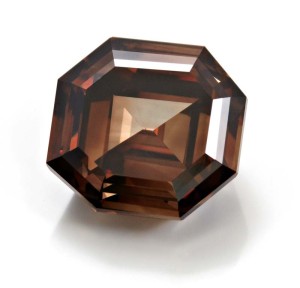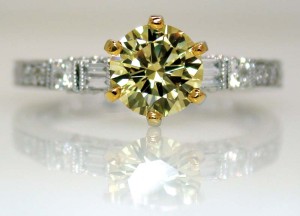Fancy shapes for fancy colours

Shape refers to the ‘canvas’ the diamond cutter chooses to display his artwork. Generally, a cutter selects a shape that yields the most weight, although cutters sometimes sacrifice a little weight in favour of better clarity or a shape outline that will be most flattering when seen in the face-up position. In general, rounds promote brilliance, hence the colour is slightly lower in saturation and slightly lighter in tone. Round brilliants are the most expensive, with premiums in excess of 40 per cent, especially in the rarer larger sizes. Shapes such as marquise, pear, and oval cause light to travel a longer distance within the stone, resulting in stronger colour in the face-up position. This is especially true with radiant-cut stones, as many cutters use this shape to ‘squeeze’ more colour out of the diamond in the face-up position. However, some radiant-cut stones do not look ‘pretty’ and in some cases, appear dull, since light is not reflecting toward the viewer’s eye. Dealers don’t often acknowledge this. In my opinion, cutters should be more interested in creating the most beautiful stone, and not simply trying to get a certain colour grade on a lab report.
Pricing fancy-coloured diamonds
In 2011, an Israel-based gemmologist launched an online wholesale pricing system for fancy-coloured diamonds that is based on the use of a digital colour master set. While the intent is noteworthy, some gemmologists, myself included, see the issue of colour grading as more complex. Although this system may better communicate and standardize colour grading, as well as provide a price range for a specific colour, some would argue it doesn’t take into account a diamond as a 3-D object with varying colour intensity on different facets. As such, pricing accuracy may be called into question.
Prices are dependent on the level of the market. Once a stone is polished, a wholesale dealer sells the stone based on the colour grade it receives from a laboratory. As stated previously, there are serious problems with the accuracy of the current colour grading system. If the industry takes steps to standardize coloured-diamond grading, the market will help dictate a stone’s value in a more consistent manner.
For now, value can be determined through various channels. For smaller commercial diamonds like yellows and browns, labs generally compare stones of similar characteristics. In the case of rarer colours, such as pink or green, as well as larger yellow stones, it is not unusual to consult active dealers. Labs may also check prices with major retailers for diamonds of similar cut, carat, clarity, and colour.
Market situation for coloured diamonds

At present, the market is strong for high-quality coloured diamonds, given their shortage.
Tsafrir Romi of Brilliant C in Toronto sees natural yellow and pink diamonds as trending strongly, which correlates to higher prices. “The demand has increased globally, but especially in the Far East and Australia,” he explains. “For example, in the past six months, the wholesale price for one-carat diamonds in natural fancy yellow has increased from $3000 US per carat to $4500 per carat, while natural fancy yellow diamonds in the one-carat to three-carat VS clarity range can vary from $6000 US per carat to $70,000 US.”
Should private individuals collect/invest in natural coloured diamonds? Supply seems to be declining, and fewer and fewer rare fancy diamonds are coming out of existing mines. And while there are plenty of websites and other sources of information extolling the enormous investment potential of coloured diamonds, there is reason for caution. A consumer who buys a not-so-rare .50-carat fancy yellow diamond may not realize the return on investment they’re hoping for in selling it a few years later beyond perhaps the rate of inflation. A five-carat vivid yellow diamond, however, is a different story.
Additionally, the point in the chain at which the diamond is purchased also plays a factor. If an investor buys a fancy-coloured diamond at retail, he or she will have a longer wait for the stone’s value to increase, as opposed to purchasing it farther up the supply chain. As a long-term investment (i.e. ideally 10 years) or as a hedge against inflation, higher-quality, fancy-coloured diamonds in larger sizes and with exceptionally rare or highly saturated colours will likely show the fastest and highest gains in price and value, although predicting a time frame is difficult to calculate. Some experts even say it can take decades for an individual to realize on their investment to any significant degree. Like any other speculative venture, numerous factors are at play when investing in diamonds, making what some describe as a ‘sure thing’ not entirely the case. Â
Consumers are only just beginning to understand what rarity means in a coloured diamond, and as word spreads, their value should increase. For example, most know pinks and blues are rare, but few are even aware fancies like violet, milky white, purple, olive, and orange exist. With less and less fine material coming out of the ground, a greater percentage of unusual and rare colours will become more interesting as investments.
 Branko Deljanin, B.Sc., GG, FGA, DUG is head gemmologist and president of Canadian Gemological Laboratory (CGL) in Vancouver. He is a regular contributor to trade and gemmological magazines and has presented reports at a number of research conferences. Deljanin is an instructor of standard and advanced gemmology programs on diamonds and coloured stones in Canada and internationally. He can be reached at info@cglworld.ca.
Branko Deljanin, B.Sc., GG, FGA, DUG is head gemmologist and president of Canadian Gemological Laboratory (CGL) in Vancouver. He is a regular contributor to trade and gemmological magazines and has presented reports at a number of research conferences. Deljanin is an instructor of standard and advanced gemmology programs on diamonds and coloured stones in Canada and internationally. He can be reached at info@cglworld.ca.





